
Question Number 16214 by Tinkutara last updated on 19/Jun/17
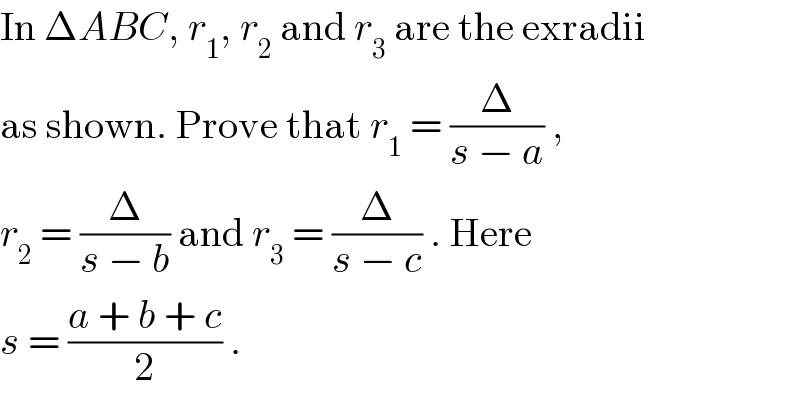
$$\mathrm{In}\:\Delta{ABC},\:{r}_{\mathrm{1}} ,\:{r}_{\mathrm{2}} \:\mathrm{and}\:{r}_{\mathrm{3}} \:\mathrm{are}\:\mathrm{the}\:\mathrm{exradii} \\ $$$$\mathrm{as}\:\mathrm{shown}.\:\mathrm{Prove}\:\mathrm{that}\:{r}_{\mathrm{1}} \:=\:\frac{\Delta}{{s}\:−\:{a}}\:, \\ $$$${r}_{\mathrm{2}} \:=\:\frac{\Delta}{{s}\:−\:{b}}\:\mathrm{and}\:{r}_{\mathrm{3}} \:=\:\frac{\Delta}{{s}\:−\:{c}}\:.\:\mathrm{Here} \\ $$$${s}\:=\:\frac{{a}\:+\:{b}\:+\:{c}}{\mathrm{2}}\:. \\ $$
Commented by Tinkutara last updated on 19/Jun/17

Commented by Tinkutara last updated on 20/Jun/17

$$\mathrm{Thanks}\:\mathrm{Sir}! \\ $$
Commented by b.e.h.i.8.3.4.1.7@gmail.com last updated on 20/Jun/17
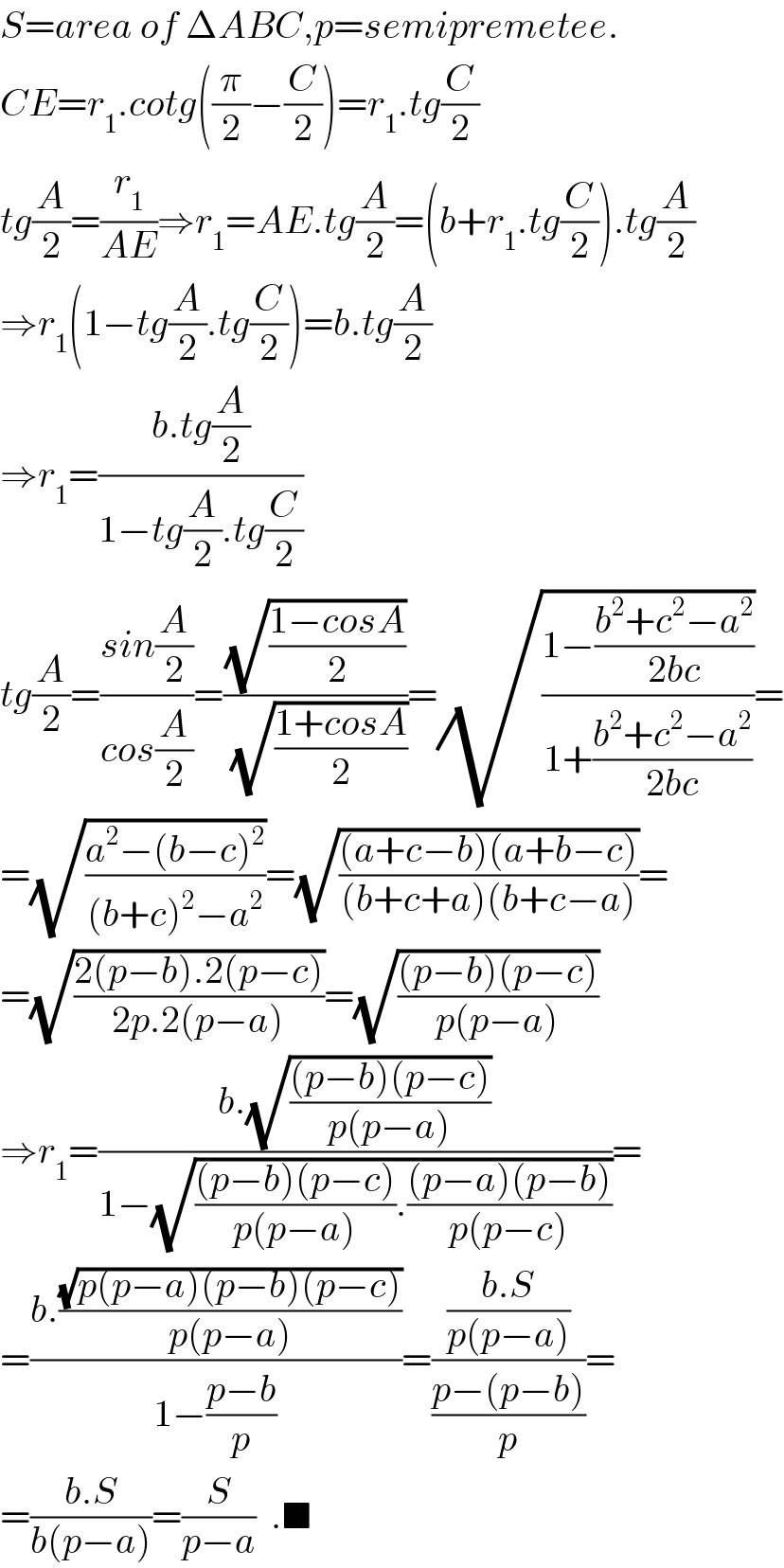
$${S}={area}\:{of}\:\Delta{ABC},{p}={semipremetee}. \\ $$$${CE}={r}_{\mathrm{1}} .{cotg}\left(\frac{\pi}{\mathrm{2}}−\frac{{C}}{\mathrm{2}}\right)={r}_{\mathrm{1}} .{tg}\frac{{C}}{\mathrm{2}} \\ $$$${tg}\frac{{A}}{\mathrm{2}}=\frac{{r}_{\mathrm{1}} }{{AE}}\Rightarrow{r}_{\mathrm{1}} ={AE}.{tg}\frac{{A}}{\mathrm{2}}=\left({b}+{r}_{\mathrm{1}} .{tg}\frac{{C}}{\mathrm{2}}\right).{tg}\frac{{A}}{\mathrm{2}} \\ $$$$\Rightarrow{r}_{\mathrm{1}} \left(\mathrm{1}−{tg}\frac{{A}}{\mathrm{2}}.{tg}\frac{{C}}{\mathrm{2}}\right)={b}.{tg}\frac{{A}}{\mathrm{2}} \\ $$$$\Rightarrow{r}_{\mathrm{1}} =\frac{{b}.{tg}\frac{{A}}{\mathrm{2}}}{\mathrm{1}−{tg}\frac{{A}}{\mathrm{2}}.{tg}\frac{{C}}{\mathrm{2}}} \\ $$$${tg}\frac{{A}}{\mathrm{2}}=\frac{{sin}\frac{{A}}{\mathrm{2}}}{{cos}\frac{{A}}{\mathrm{2}}}=\frac{\sqrt{\frac{\mathrm{1}−{cosA}}{\mathrm{2}}}}{\sqrt{\frac{\mathrm{1}+{cosA}}{\mathrm{2}}}}=\sqrt{\frac{\mathrm{1}−\frac{{b}^{\mathrm{2}} +{c}^{\mathrm{2}} −{a}^{\mathrm{2}} }{\mathrm{2}{bc}}}{\mathrm{1}+\frac{{b}^{\mathrm{2}} +{c}^{\mathrm{2}} −{a}^{\mathrm{2}} }{\mathrm{2}{bc}}}}= \\ $$$$=\sqrt{\frac{{a}^{\mathrm{2}} −\left({b}−{c}\right)^{\mathrm{2}} }{\left({b}+{c}\right)^{\mathrm{2}} −{a}^{\mathrm{2}} }}=\sqrt{\frac{\left({a}+{c}−{b}\right)\left({a}+{b}−{c}\right)}{\left({b}+{c}+{a}\right)\left({b}+{c}−{a}\right)}}= \\ $$$$=\sqrt{\frac{\mathrm{2}\left({p}−{b}\right).\mathrm{2}\left({p}−{c}\right)}{\mathrm{2}{p}.\mathrm{2}\left({p}−{a}\right)}}=\sqrt{\frac{\left({p}−{b}\right)\left({p}−{c}\right)}{{p}\left({p}−{a}\right)}} \\ $$$$\Rightarrow{r}_{\mathrm{1}} =\frac{{b}.\sqrt{\frac{\left({p}−{b}\right)\left({p}−{c}\right)}{{p}\left({p}−{a}\right)}}}{\mathrm{1}−\sqrt{\frac{\left({p}−{b}\right)\left({p}−{c}\right)}{{p}\left({p}−{a}\right)}.\frac{\left({p}−{a}\right)\left({p}−{b}\right)}{{p}\left({p}−{c}\right)}}}= \\ $$$$=\frac{{b}.\frac{\sqrt{{p}\left({p}−{a}\right)\left({p}−{b}\right)\left({p}−{c}\right)}}{{p}\left({p}−{a}\right)}}{\mathrm{1}−\frac{{p}−{b}}{{p}}}=\frac{\frac{{b}.{S}}{{p}\left({p}−{a}\right)}}{\frac{{p}−\left({p}−{b}\right)}{{p}}}= \\ $$$$=\frac{{b}.{S}}{{b}\left({p}−{a}\right)}=\frac{{S}}{{p}−{a}}\:\:.\blacksquare \\ $$
Commented by b.e.h.i.8.3.4.1.7@gmail.com last updated on 20/Jun/17
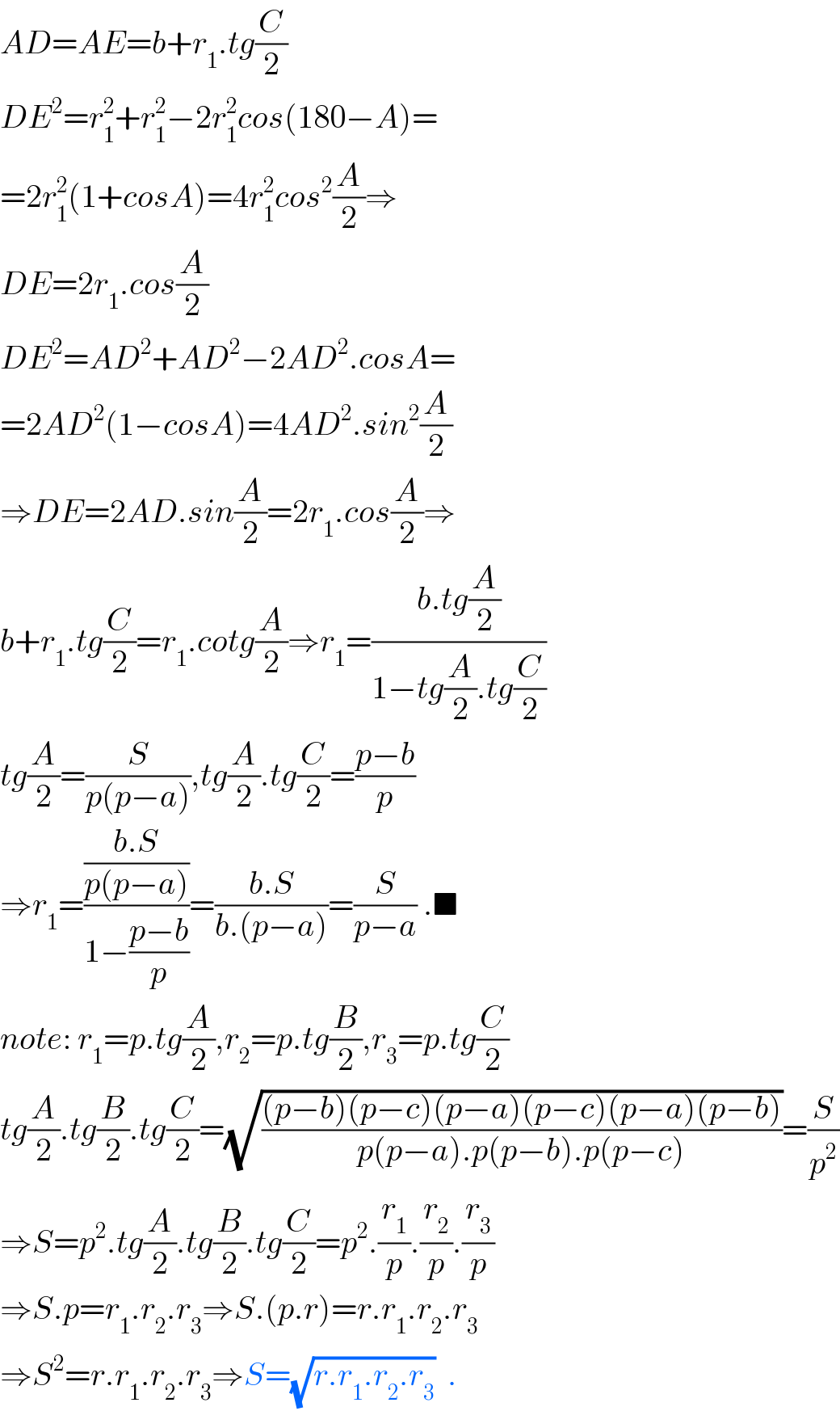
$${AD}={AE}={b}+{r}_{\mathrm{1}} .{tg}\frac{{C}}{\mathrm{2}} \\ $$$${DE}^{\mathrm{2}} ={r}_{\mathrm{1}} ^{\mathrm{2}} +{r}_{\mathrm{1}} ^{\mathrm{2}} −\mathrm{2}{r}_{\mathrm{1}} ^{\mathrm{2}} {cos}\left(\mathrm{180}−{A}\right)= \\ $$$$=\mathrm{2}{r}_{\mathrm{1}} ^{\mathrm{2}} \left(\mathrm{1}+{cosA}\right)=\mathrm{4}{r}_{\mathrm{1}} ^{\mathrm{2}} {cos}^{\mathrm{2}} \frac{{A}}{\mathrm{2}}\Rightarrow \\ $$$${DE}=\mathrm{2}{r}_{\mathrm{1}} .{cos}\frac{{A}}{\mathrm{2}} \\ $$$${DE}^{\mathrm{2}} ={AD}^{\mathrm{2}} +{AD}^{\mathrm{2}} −\mathrm{2}{AD}^{\mathrm{2}} .{cosA}= \\ $$$$=\mathrm{2}{AD}^{\mathrm{2}} \left(\mathrm{1}−{cosA}\right)=\mathrm{4}{AD}^{\mathrm{2}} .{sin}^{\mathrm{2}} \frac{{A}}{\mathrm{2}} \\ $$$$\Rightarrow{DE}=\mathrm{2}{AD}.{sin}\frac{{A}}{\mathrm{2}}=\mathrm{2}{r}_{\mathrm{1}} .{cos}\frac{{A}}{\mathrm{2}}\Rightarrow \\ $$$${b}+{r}_{\mathrm{1}} .{tg}\frac{{C}}{\mathrm{2}}={r}_{\mathrm{1}} .{cotg}\frac{{A}}{\mathrm{2}}\Rightarrow{r}_{\mathrm{1}} =\frac{{b}.{tg}\frac{{A}}{\mathrm{2}}}{\mathrm{1}−{tg}\frac{{A}}{\mathrm{2}}.{tg}\frac{{C}}{\mathrm{2}}} \\ $$$${tg}\frac{{A}}{\mathrm{2}}=\frac{{S}}{{p}\left({p}−{a}\right)},{tg}\frac{{A}}{\mathrm{2}}.{tg}\frac{{C}}{\mathrm{2}}=\frac{{p}−{b}}{{p}} \\ $$$$\Rightarrow{r}_{\mathrm{1}} =\frac{\frac{{b}.{S}}{{p}\left({p}−{a}\right)}}{\mathrm{1}−\frac{{p}−{b}}{{p}}}=\frac{{b}.{S}}{{b}.\left({p}−{a}\right)}=\frac{{S}}{{p}−{a}}\:.\blacksquare \\ $$$${note}:\:{r}_{\mathrm{1}} ={p}.{tg}\frac{{A}}{\mathrm{2}},{r}_{\mathrm{2}} ={p}.{tg}\frac{{B}}{\mathrm{2}},{r}_{\mathrm{3}} ={p}.{tg}\frac{{C}}{\mathrm{2}} \\ $$$${tg}\frac{{A}}{\mathrm{2}}.{tg}\frac{{B}}{\mathrm{2}}.{tg}\frac{{C}}{\mathrm{2}}=\sqrt{\frac{\left({p}−{b}\right)\left({p}−{c}\right)\left({p}−{a}\right)\left({p}−{c}\right)\left({p}−{a}\right)\left({p}−{b}\right)}{{p}\left({p}−{a}\right).{p}\left({p}−{b}\right).{p}\left({p}−{c}\right)}}=\frac{{S}}{{p}^{\mathrm{2}} } \\ $$$$\Rightarrow{S}={p}^{\mathrm{2}} .{tg}\frac{{A}}{\mathrm{2}}.{tg}\frac{{B}}{\mathrm{2}}.{tg}\frac{{C}}{\mathrm{2}}={p}^{\mathrm{2}} .\frac{{r}_{\mathrm{1}} }{{p}}.\frac{{r}_{\mathrm{2}} }{{p}}.\frac{{r}_{\mathrm{3}} }{{p}} \\ $$$$\Rightarrow{S}.{p}={r}_{\mathrm{1}} .{r}_{\mathrm{2}} .{r}_{\mathrm{3}} \Rightarrow{S}.\left({p}.{r}\right)={r}.{r}_{\mathrm{1}} .{r}_{\mathrm{2}} .{r}_{\mathrm{3}} \\ $$$$\Rightarrow{S}^{\mathrm{2}} ={r}.{r}_{\mathrm{1}} .{r}_{\mathrm{2}} .{r}_{\mathrm{3}} \Rightarrow{S}=\sqrt{{r}.{r}_{\mathrm{1}} .{r}_{\mathrm{2}} .{r}_{\mathrm{3}} }\:\:. \\ $$
Answered by ajfour last updated on 19/Jun/17

Commented by Tinkutara last updated on 22/Jun/17

$$\mathrm{Then}\:\mathrm{this}\:\mathrm{procedure}\:\mathrm{is}\:\mathrm{wrong}?\:\mathrm{Or}\:\mathrm{how} \\ $$$$\mathrm{to}\:\mathrm{proceed}\:\mathrm{further}\:\mathrm{using}\:\mathrm{this}\:\mathrm{method}? \\ $$
Commented by ajfour last updated on 22/Jun/17
![lengths of tangent from B to excircle of radius r_1 are BD=BE =ma lengths of tangent from C to excircle of radius r_1 are CD=CF =na ma+na = a ⇒ m+n = 1 ......(i) If Δ is the area of △ABC, Area of entire figure (consider AG joined (D may or may not lie on it) is A=Δ+2[(r_1 /2)(ma)+(r_1 /2)(na)] =Δ+r_1 (ma+na) A =Δ+r_1 a (as ma+na=a) ....(ii) but A is also given by A=(1/2)(r_1 )(c+ma)+(1/2)(r_1 )(b+na) = (r_1 /2)(b+c+ma+na) A = (r_1 /2)(a+b+c) (as m+n=1) ....(iii) equating (ii) and (iii): A = (r_1 /2)(a+b+c) = Δ+r_1 a or r_1 s−r_1 a =Δ r_1 = (𝚫/(s−a)) where s=((a+b+c)/2) . similarly r_2 =(Δ/(s−b))and r_3 =(Δ/(s−c)) i am thinking how to prove..](Q16225.png)
$${lengths}\:\:{of}\:{tangent}\:{from}\:{B}\:{to} \\ $$$${excircle}\:{of}\:{radius}\:{r}_{\mathrm{1}} \:{are} \\ $$$$\:\:\:{BD}={BE}\:={ma}\: \\ $$$${lengths}\:\:{of}\:{tangent}\:{from}\:{C}\:{to} \\ $$$${excircle}\:{of}\:{radius}\:{r}_{\mathrm{1}} \:{are} \\ $$$$\:\:\:{CD}={CF}\:={na} \\ $$$$\:\:\:{ma}+{na}\:=\:{a} \\ $$$$\Rightarrow\:\:\:\boldsymbol{{m}}+\boldsymbol{{n}}\:=\:\mathrm{1}\:\:\:......\left(\boldsymbol{{i}}\right) \\ $$$${If}\:\Delta\:{is}\:{the}\:{area}\:{of}\:\bigtriangleup{ABC}, \\ $$$${Area}\:{of}\:{entire}\:{figure}\:\left({consider}\right. \\ $$$${AG}\:{joined}\:\left({D}\:{may}\:{or}\:{may}\:{not}\right. \\ $$$$\left.\:{lie}\:{on}\:{it}\right)\:{is} \\ $$$$\:\:\:\:{A}=\Delta+\mathrm{2}\left[\frac{{r}_{\mathrm{1}} }{\mathrm{2}}\left({ma}\right)+\frac{{r}_{\mathrm{1}} }{\mathrm{2}}\left({na}\right)\right] \\ $$$$\:\:\:\:\:\:\:=\Delta+{r}_{\mathrm{1}} \left({ma}+{na}\right)\: \\ $$$$\:\:\:\:\:\:{A}\:=\Delta+{r}_{\mathrm{1}} {a}\:\:\:\:\:\:\:\:\:\:\:\:\left({as}\:{ma}+{na}={a}\right) \\ $$$$\:\:\:\:\:\:\:\:\:\:\:\:\:\:\:\:\:\:\:\:\:\:\:\:\:\:\:\:\:\:\:\:\:....\left({ii}\right) \\ $$$${but}\:{A}\:{is}\:{also}\:{given}\:{by} \\ $$$$\:{A}=\frac{\mathrm{1}}{\mathrm{2}}\left({r}_{\mathrm{1}} \right)\left({c}+{ma}\right)+\frac{\mathrm{1}}{\mathrm{2}}\left({r}_{\mathrm{1}} \right)\left({b}+{na}\right) \\ $$$$\:\:\:\:=\:\frac{{r}_{\mathrm{1}} }{\mathrm{2}}\left({b}+{c}+{ma}+{na}\right) \\ $$$$\:\:{A}\:=\:\frac{{r}_{\mathrm{1}} }{\mathrm{2}}\left({a}+{b}+{c}\right)\:\:\:\:\:\:\:\:\:\:\:\left({as}\:{m}+{n}=\mathrm{1}\right) \\ $$$$\:\:\:\:\:\:\:\:\:\:\:\:\:\:\:\:\:\:\:\:\:\:\:\:\:\:\:\:\:\:\:\:\:\:....\left({iii}\right) \\ $$$$\:\:{equating}\:\:\:\left({ii}\right)\:{and}\:\left({iii}\right): \\ $$$$\:\:{A}\:=\:\frac{{r}_{\mathrm{1}} }{\mathrm{2}}\left({a}+{b}+{c}\right)\:=\:\Delta+{r}_{\mathrm{1}} {a} \\ $$$${or}\:\:\:\:\:\:{r}_{\mathrm{1}} {s}−{r}_{\mathrm{1}} {a}\:=\Delta \\ $$$$\:\:\:\:\:\boldsymbol{{r}}_{\mathrm{1}} \:=\:\frac{\boldsymbol{\Delta}}{{s}−{a}}\:\:\:\:\:\:\:{where}\:{s}=\frac{{a}+{b}+{c}}{\mathrm{2}}\:. \\ $$$$\:{similarly}\:\:\boldsymbol{{r}}_{\mathrm{2}} \:=\frac{\Delta}{{s}−{b}}{and}\:\boldsymbol{{r}}_{\mathrm{3}} =\frac{\Delta}{{s}−{c}} \\ $$$$\:\:{i}\:{am}\:{thinking}\:{how}\:{to}\:{prove}.. \\ $$$$ \\ $$
Commented by mrW1 last updated on 19/Jun/17

$$\mathrm{Excellent}\:\mathrm{sir}! \\ $$
Commented by ajfour last updated on 22/Jun/17

$$\:{error}\:{writing}\:{eqn}.\:\left({i}\right)\:{but}\:{i}\:{have} \\ $$$${used}\:{ma}+{na}\:=\:{a}\:,\:{itself},\:{you}\:{can} \\ $$$${see}\:{for}\:{yourself}. \\ $$
Answered by mrW1 last updated on 20/Jun/17
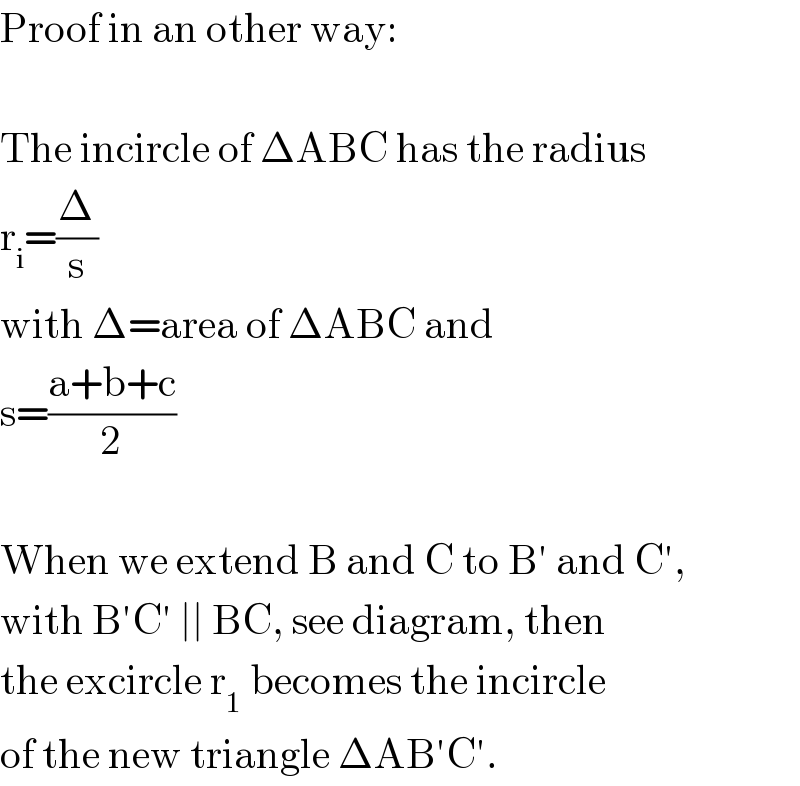
$$\mathrm{Proof}\:\mathrm{in}\:\mathrm{an}\:\mathrm{other}\:\mathrm{way}: \\ $$$$ \\ $$$$\mathrm{The}\:\mathrm{incircle}\:\mathrm{of}\:\Delta\mathrm{ABC}\:\mathrm{has}\:\mathrm{the}\:\mathrm{radius} \\ $$$$\mathrm{r}_{\mathrm{i}} =\frac{\Delta}{\mathrm{s}} \\ $$$$\mathrm{with}\:\Delta=\mathrm{area}\:\mathrm{of}\:\Delta\mathrm{ABC}\:\mathrm{and} \\ $$$$\mathrm{s}=\frac{\mathrm{a}+\mathrm{b}+\mathrm{c}}{\mathrm{2}} \\ $$$$ \\ $$$$\mathrm{When}\:\mathrm{we}\:\mathrm{extend}\:\mathrm{B}\:\mathrm{and}\:\mathrm{C}\:\mathrm{to}\:\mathrm{B}'\:\mathrm{and}\:\mathrm{C}', \\ $$$$\mathrm{with}\:\mathrm{B}'\mathrm{C}'\:\mid\mid\:\mathrm{BC},\:\mathrm{see}\:\mathrm{diagram},\:\mathrm{then} \\ $$$$\mathrm{the}\:\mathrm{excircle}\:\mathrm{r}_{\mathrm{1}} \:\mathrm{becomes}\:\mathrm{the}\:\mathrm{incircle}\: \\ $$$$\mathrm{of}\:\mathrm{the}\:\mathrm{new}\:\mathrm{triangle}\:\Delta\mathrm{AB}'\mathrm{C}'. \\ $$
Commented by mrW1 last updated on 19/Jun/17

Commented by mrW1 last updated on 20/Jun/17
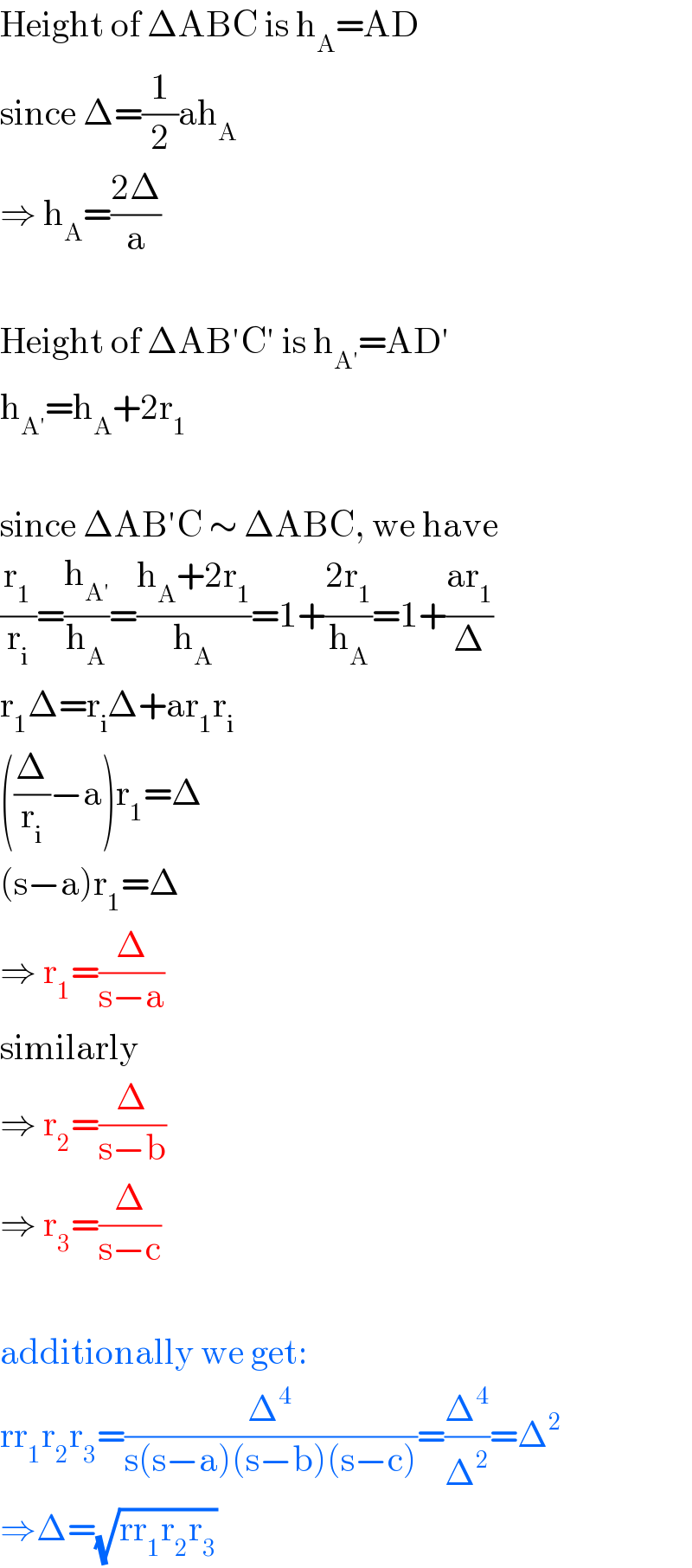
$$\mathrm{Height}\:\mathrm{of}\:\Delta\mathrm{ABC}\:\mathrm{is}\:\mathrm{h}_{\mathrm{A}} =\mathrm{AD} \\ $$$$\mathrm{since}\:\Delta=\frac{\mathrm{1}}{\mathrm{2}}\mathrm{ah}_{\mathrm{A}} \\ $$$$\Rightarrow\:\mathrm{h}_{\mathrm{A}} =\frac{\mathrm{2}\Delta}{\mathrm{a}} \\ $$$$ \\ $$$$\mathrm{Height}\:\mathrm{of}\:\Delta\mathrm{AB}'\mathrm{C}'\:\mathrm{is}\:\mathrm{h}_{\mathrm{A}'} =\mathrm{AD}' \\ $$$$\mathrm{h}_{\mathrm{A}'} =\mathrm{h}_{\mathrm{A}} +\mathrm{2r}_{\mathrm{1}} \\ $$$$ \\ $$$$\mathrm{since}\:\Delta\mathrm{AB}'\mathrm{C}\:\sim\:\Delta\mathrm{ABC},\:\mathrm{we}\:\mathrm{have} \\ $$$$\frac{\mathrm{r}_{\mathrm{1}} }{\mathrm{r}_{\mathrm{i}} }=\frac{\mathrm{h}_{\mathrm{A}'} }{\mathrm{h}_{\mathrm{A}} }=\frac{\mathrm{h}_{\mathrm{A}} +\mathrm{2r}_{\mathrm{1}} }{\mathrm{h}_{\mathrm{A}} }=\mathrm{1}+\frac{\mathrm{2r}_{\mathrm{1}} }{\mathrm{h}_{\mathrm{A}} }=\mathrm{1}+\frac{\mathrm{ar}_{\mathrm{1}} }{\Delta} \\ $$$$\mathrm{r}_{\mathrm{1}} \Delta=\mathrm{r}_{\mathrm{i}} \Delta+\mathrm{ar}_{\mathrm{1}} \mathrm{r}_{\mathrm{i}} \\ $$$$\left(\frac{\Delta}{\mathrm{r}_{\mathrm{i}} }−\mathrm{a}\right)\mathrm{r}_{\mathrm{1}} =\Delta \\ $$$$\left(\mathrm{s}−\mathrm{a}\right)\mathrm{r}_{\mathrm{1}} =\Delta \\ $$$$\Rightarrow\:\mathrm{r}_{\mathrm{1}} =\frac{\Delta}{\mathrm{s}−\mathrm{a}} \\ $$$$\mathrm{similarly} \\ $$$$\Rightarrow\:\mathrm{r}_{\mathrm{2}} =\frac{\Delta}{\mathrm{s}−\mathrm{b}} \\ $$$$\Rightarrow\:\mathrm{r}_{\mathrm{3}} =\frac{\Delta}{\mathrm{s}−\mathrm{c}} \\ $$$$ \\ $$$$\mathrm{additionally}\:\mathrm{we}\:\mathrm{get}: \\ $$$$\mathrm{rr}_{\mathrm{1}} \mathrm{r}_{\mathrm{2}} \mathrm{r}_{\mathrm{3}} =\frac{\Delta^{\mathrm{4}} }{\mathrm{s}\left(\mathrm{s}−\mathrm{a}\right)\left(\mathrm{s}−\mathrm{b}\right)\left(\mathrm{s}−\mathrm{c}\right)}=\frac{\Delta^{\mathrm{4}} }{\Delta^{\mathrm{2}} }=\Delta^{\mathrm{2}} \\ $$$$\Rightarrow\Delta=\sqrt{\mathrm{rr}_{\mathrm{1}} \mathrm{r}_{\mathrm{2}} \mathrm{r}_{\mathrm{3}} } \\ $$
Commented by Tinkutara last updated on 20/Jun/17

$$\mathrm{Thanks}\:\mathrm{Sir}! \\ $$
